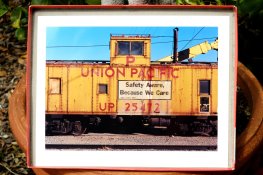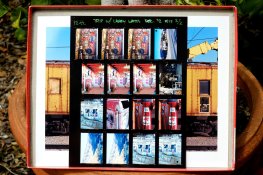Daniel, these are impressive - but you have certainly chosen your subjects carefully, It seems to lend itself to bright subjects where there is little difference in light over the subject. My pictures were of landscapes and country barns where there were distant hills, and the hills in particular were awful; another poster explained how atmospheric refraction may make the distant light more blue, and Ektar is just being "accurate" -- not much use to me, however, if it is accurate without a brain to interpret colors.
I did see that on your proof sheet, a few of the images did seem to have a blue cast. Especially the fourth picture on the top row.
These posts have been very useful, and I have picked up some useful information. It would seem first, to treat the film as a 50 ASA film; and second, pick bright subjects with even illumination. And I still think that processing tolerance is an issue; maybe Ektar is more finicky than other emulsions I have developed successfully. I also look forward to seeing if paper choice makes a difference.
I will pack a few rolls of Ektar for my trip, along with everything else, and an extra camera body so I can shoot it alongside Portra or whatever else I take with me.
Thanks

I forgot to include the type of lighting, normally I don't record such things in my exposure data logbook(one of about 5 I have scattered around the house

) since its usually apparent from contact sheet what kind of lighting it is for the scene...
Lighting(for the train shots, and the majority of the contact sheet): broad, raw California sunshine! Basically a "point light source", creating hard, direct shadows with high contrast. The inside(blue room) shots were all available light, a mixture of fluorescent and the neon mixed lighting, with a few open doors(it was a restoration shop off Hwy 58 going across to Bakersfield from Barstow) so a myriad of color balances, too much to try and filter for each individual source

Just remember: EXPOSURE DETERMINES SHADOW DENSITY, DEVELOPMENT DETERMINES HOW/WHERE YOUR HIGHLIGHTS FALL.
EVEN WITH COLOR! I have employed a spot meter the past few years to determine the "SBR"(subject brightness range) of a particular scene, and how it falls with how I've calculated I like to expose/develop the film.
Most people use "normal" development 99% of the time, and yes, that allows them(generally) a well processed negative/chrome. However, I have found that for MY photographs, I NEED pushes & pulls to REALLY get the most out of a film stock. I'm still in the testing stages of such, mostly since I've been doing such with sheet(4x5) film, and those costs DO add up

. I primarily shoot rollfilm(120/220) for "session" type photographs, where things don't change much lighting-wise.
Filtering: I now ALWAYS carry an 81A(at minimum, also an 81B and a CC05/10M) filter with me when shooting color. Even since I drum scan the majority of my "keepers" film-wise, and it allows a wonderful amount of control, filtering the lens pre/in-capture just makes life easier(and more predictable)! I also make use of graduated filters(LEE) in a lot of cases, simply because it allows me to get as much "meat" in a negative as possible w/o having to do much post-work(or none at all other than fine tuning color balance for my tastes and printing it!
Finally,
Since you've stated that you're GOING(?) on a trip, I'd advise that unless you REALLY KNOW a film stock well, to not use it for "once in a lifetime" shots which might be hard(or seemingly impossible) to reproduce w/o much effort/travel. If you KNOW Portra for example, and know its limitations/capabilities, then I'd use it. Same goes with ANY film. But Ektar CAN deliver(as you see in my prints above, with almost a straight print w/ minimal color correction vs other Kodak film stock filter settings for Fuji glossy CA paper(my normal).
my recommendation: buy 10 rolls of film before your trip, 5 rolls of Portra 160 or 400(this is a great film IMO), and 5 rolls of Ektar. Shoot the same scenes with both, and bracket each film in 1/3ASA increments downward from its box "speed". I have come to realized that for ME, ASA 50 works best for Ektar 100 processed "normally", and provides more shadow density, but the highlights still have a sparkle to them when printed down density-wise. But definitely do some testing pre-trip so you have a gauge to work off of.
cheers,
Dan















 ) since its usually apparent from contact sheet what kind of lighting it is for the scene...
) since its usually apparent from contact sheet what kind of lighting it is for the scene...



